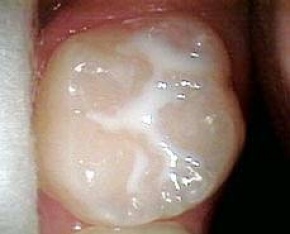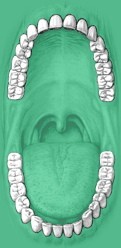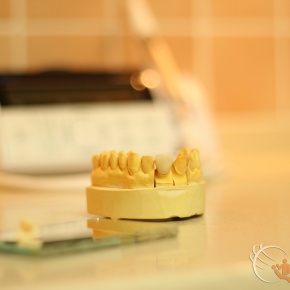It's important for pregnant women to have a complete dental exam and have any cavities or gum disease treated. For more information, see the topic Pregnancy.
Teething
Your child's first teeth usually begin to break through the gums (erupt) at about 6 months of age, although the timing varies among children. All of the 20 primary teeth should come in between the ages of 6 months and 3 years. Your child will lose his or her primary teeth between the ages of 6 and 11. For more information, see the topic Teething.
Your child's first permanent teeth (molars) usually erupt behind the primary teeth at about age 6. The last permanent teeth usually erupt between the ages of 12 and 21.
See more information on your child's tooth development.
Starting dental care for children
By the time your child is 6 months of age, your doctor should assess the likelihood of your child having future dental problems. This may include a dental exam of the mother and her dental history, as the condition of her teeth can often predict her child's teeth. If the doctor thinks your child will have dental problems, be sure your child sees a dentist by his or her first birthday or 6 months after the first primary teeth appear, whichever comes first. After your first visit, schedule regular visits every 6 months or as your dentist recommends.
Experts recommend that your child's dental care start at 12 months of age. Babies with dental problems caused by injury, disease, or a developmental problem should be seen by a children's (pediatric) dentist right away. If these dental problems are not limited to the surfaces of the teeth, your baby should also be seen by a children's doctor (pediatrician) or your family doctor. For more information, see the topics Mouth Problems, Noninjury and Mouth and Dental Injuries.
Tooth care
It's best to start good oral health habits before permanent teeth come in.
- Parents and caregivers often share spoons, forks, and other utensils with babies. The saliva you may leave on the utensil contains bacteria that can cause tooth decay. Sometimes, kissing can also transfer bacteria. You can help prevent early childhood tooth decay in your child by making sure that your family practices good dental health habits. Keeping your own teeth and gums healthy reduces the risk of transferring tooth decay bacteria to your child.
- Do not put your infant or small child to bed with a bottle of milk, formula, juice, or other product that contains sugar. The sugar and acids in these liquids can cause tooth decay. Do not prop the bottle up in your baby's mouth. Remove the bottle as soon as your baby is done feeding or is asleep. Breast-feeding your infant to sleep is safe, however. Encourage your baby to begin drinking from a cup at about 4 to 6 months of age.
- Discuss your child's fluoride needs with your dentist if your local water supply does not contain enough fluoride. To find out, call your local water company or health department. If you have your own well, have your water checked to determine whether your family needs fluoride from other sources. You may also need to provide fluoride to your children if you use bottled water for cooking or drinking. Normal amounts of fluoride added to public water supplies and bottled water are safe for children and adults. If your child needs extra fluoride, your dentist may recommend supplements. Use these supplements only as directed. And keep them out of reach of your child. Too much fluoride can be toxic and can stain a child’s teeth.
- Give your child nutritious foods to maintain healthy gums, develop strong teeth, and avoid tooth decay. These include whole grains, vegetables, and fruits. Try to avoid foods that are high in sugar and processed carbohydrates, such as pastries, pasta, and white bread.
- Do not give your child mouthwashes that contain alcohol. If your child age 6 or older has cavities, ask the dentist if your child should try mouthwash that contains fluoride. But watch to make sure your child does not swallow it.
- Keep your child away from cigarette smoke (secondhand smoke).
- Children play hard, sometimes hard enough to knock out or break a tooth. Learn how to prevent injuries to teeth and what to do in a dental emergency. For more information, see the topic Mouth and Dental Injuries.
- If your child sucks his or her fingers or thumb, help your child to stop. If the child can't stop, see your dentist. For more information, see the topic Thumb-Sucking.
Brushing and flossing
- Start cleaning your child's teeth with a soft cloth or gauze pad as soon as the teeth come in. As more teeth erupt, clean teeth with a soft toothbrush.
- Because too much fluoride can be toxic and can stain a child’s teeth, ask your doctor or dentist if its okay to use fluoride toothpaste. Brush your child's teeth for the first few years, until your child can do it alone (usually at about age 3). Teach your child not to swallow the toothpaste.
- Your child can learn how to brush his or her own teeth at about age 3. Children should be brushing their own teeth morning and night by age 4, although you should supervise and check for proper cleaning.
- Give your child a small, soft toothbrush, and apply fluoridated toothpaste in an amount about the size of a small green pea. Encourage your child to watch you and older siblings brush teeth. A good teaching method is to have your child brush in the morning and you brush at night until your child masters the skill.
- Start flossing your child's teeth as soon as they touch each other. You may find plastic flossing tools helpful. Talk with your dentist about the right timing and technique to floss your child's teeth and how to teach your child to floss.
- Use disclosing tablets from time to time to see whether any plaque is left on the teeth after brushing. Disclosing tablets are chewable and will color any plaque left on the teeth after the child brushes. You can buy these at most drugstores.
When is the time of sealing pit and fissure?
Mostly in the age of 6 should we pay attention, because at this time comes out the first permanent molar tooth, followed by the other teeth. As a general rule may remark that within 6 months after the teeth eruption the teeth’ fissures should be treated. The treatment of the teeth after the ozone disinfection happens with pit and fissure sealant, which they flowing into the concavity between the cusps. The treatment is absolutely painless, quick and very efficient. The monthly examination of the teeth is necessary.

The forms of sealing of pit and fissure
General sealing of pit and fissure: the affected teeth’ fissure system is discoloration and decay free. Extended sealing of pit and fissure: in the affected teeth’ fissure system there is discoloration or surface decay. In such case the narrow exploration of the fissure becomes necessary. After the ozone treatment we fill up the tooth’s dental layer with so called glasiomer cement, which is chemically fixed into the tooth tissue. Onto this stratify the fine grained composite filling material according to the original form of the tooth, then covered with pit and fissure sealant.

The children dentistry is a very important specialty of the dentistry, because our childhood’s dental status may determine to our whole life the frequency of our dental visits.
Many people think that the milk-tooth don’t have to fill in, because instead of those will grow permanent tooth. THIS IS MYTH!
The starting inflammation from the decayed milk-tooth can spread to the permanent teeth ‘germ, thus they have been damaged before they reach the mouth. We create such filling material into the milk-teeth, which are able to intake and transmit fluoride.
Important to know that before tooth changing the permanent teeth appear behind the milk-teeth. All parents should particularly take into account this, because (many people look these only milk-tooth) without proper attention before the other permanent tooth get out, these will be decayed.
The first appearing permanent molar tooth should sealing of pit and fissure. This means that without drilling, after thoroughly cleaning the tooth we fill in the deep fissured with a special liquid filling material, thus making them easier to clean.
The importance of the semi-annual inspection is also true for children, as for adults.




